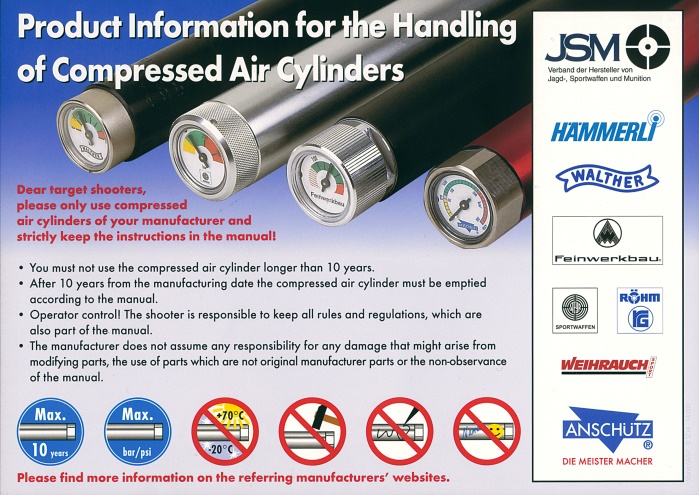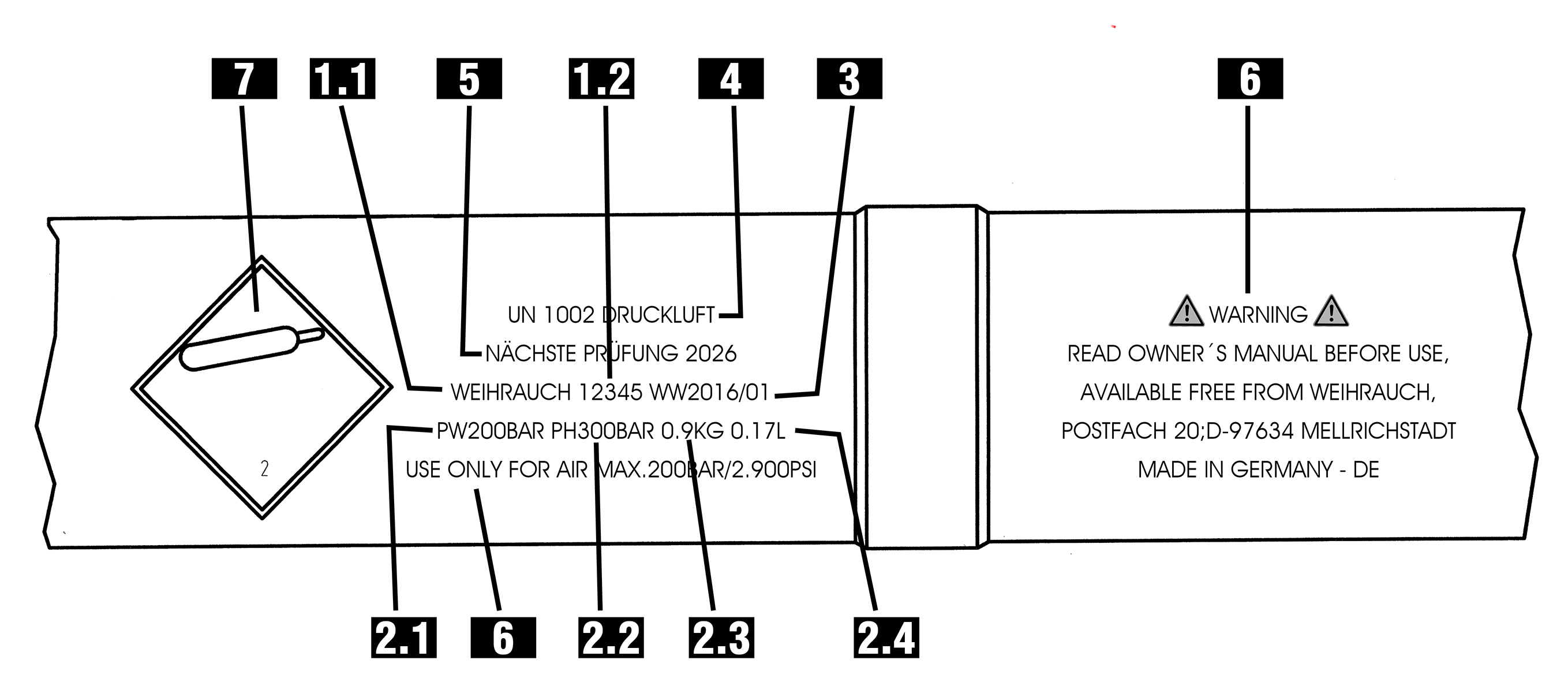
General information for our compressed air cylinders of model HW 110:
The compressed air cylinders manufactured by Weihrauch are produced according to the
German Pressure Vessel Code, but have not to be certified (i.e. by TÜV, etc.). The manufacturer must assure the safety of the compressed air cylinder.
Based on this, the lifetime of the compressed air cylinders was limited to 10 years. After this
time period the compressed air cylinders should be depressurized and must not to be used anymore. Therefore all our compressed air cylinders in use today are marked with the manufacturing date and the expiration date (“nächste Prüfung”). Also see the manual. Air cylinders which are leaky and defective must be emptied and not be used anymore too. Relevant laws of your country should be followed as well.
Weihrauch does not assume any liability in regard to the safety of compressed air cylinders being used longer than 10 years.
However owning to their different characteristics of the air cartridges out of steel the manufacturer provides the option of retesting them after 10 years. If no defects are discovered in this test, the working life can be extended a single time for another 10 years. Hence, a total maximum service life of 20 years is possible (e. g.: the service life of a 11 years old compressed air cylinder is extended by additional 9 years only). The working life of a compressed air cylinder that is more than 20 years old cannot be extended by means of another repeated testing. When the maximum permissible service life has been reached, the cylinder must be emptied in a safe manner and disposed. This repeated testing after 10 years can only be carried out by us at our facilities. This testing and the possible prolonging does only apply for the steel tube.
Please also check the compressed air cylinders for cracks. If you notice any cracks or a similar damage, please empty the compressed air cylinder at once and send it to Weihrauch for inspection. The surface of your compressed air cylinder must not be manipulated. Particularly do not engrave or otherwise penetrate the surface of the compressed air cylinder as this would lead to a damage of the cylinder which might entail a safety risk, a sudden failure of the compressed air cylinder or to serious injuries.
Protect air cylinders from the effects of external force, i. e. falling. Never attempt to engrave, stamp, dismantle or to make mechanical modifications to any air cylinder. Only the manufacturer may dismantle or open the valves and manometer (pressure gauge).
Each shooter is solely responsible for his air cylinder. Compressed air cylinders with expired usage period must not be used anymore. Weihrauch expressly is stressing out that in case of a usage exceeding this period, the shooter does it at his own risk. Safety can no longer be guaranteed and even severe injuries might occur.
By filling and emptying of our air cylinders within normal use the high-quality material is subjected to a strong strain. This special load was considered in the design of the cylinder and by fixing a maximum period of use.
Attention: You are only allowed to use Original-Weihrauch-air cartridges (max. 200 bar). Repairs can only be made by the manufacturer using original spare parts. Otherwise the manufacturer is exonerated from any liability and guarantee. For the prolonging of the working life of your air cartridge your gun dealer has only to return the complete air cartridge.
If you need a new compressed air cylinder, please contact your local dealer. Weihrauch does not sell its products directly to the public. Please provide us your address. We will then guide you to a supply source and contact in your area.
We strongly recommend drawing your attention to the points mentioned above. Weihrauch does not assume any liability for events due to disregarding the notification above.

Description of the elements according to ADR:
1.1 manufacturer
1.2 serial number
2.1 operating pressure (bar)
2.2 test pressure (bar)
2.3 weight, empty (kg)
2.4 capacity (l)
3 date of manufacture (year/month)
4 gas designation (compressed air)
5 date of the next check (year)
6 warnings
7 classification of danger (sticker)

